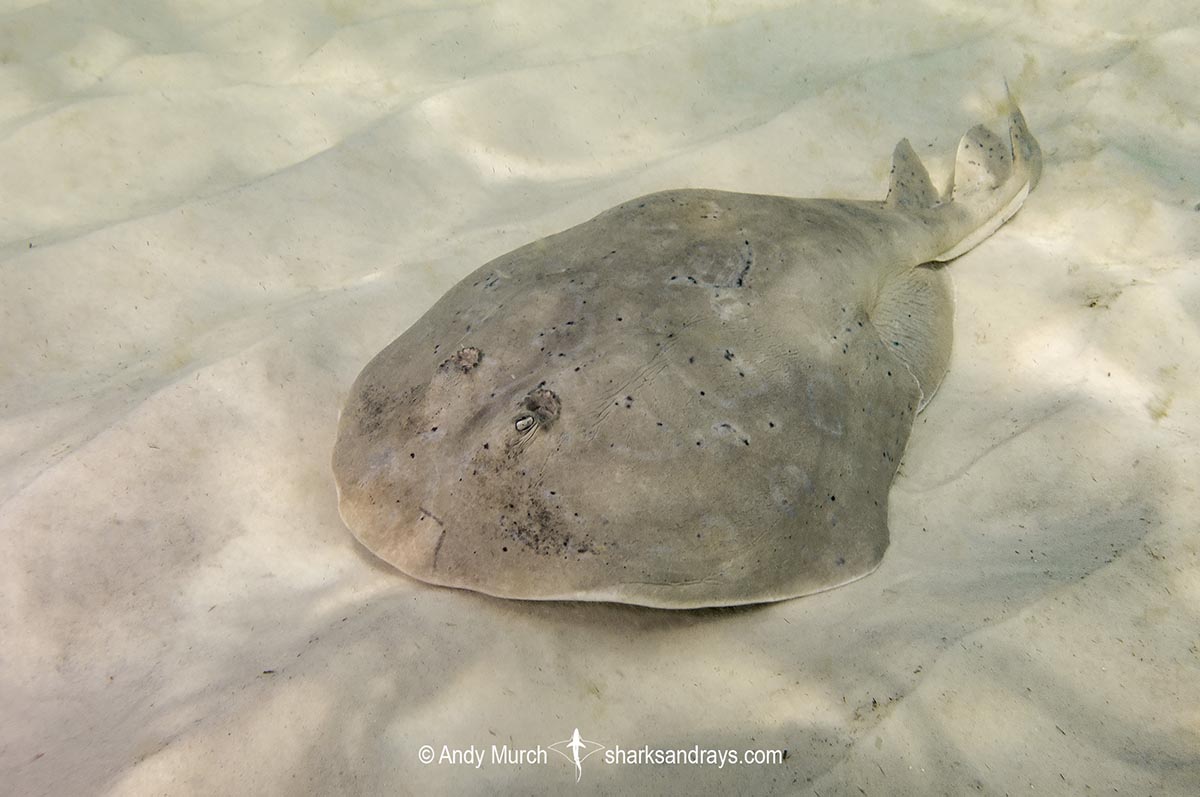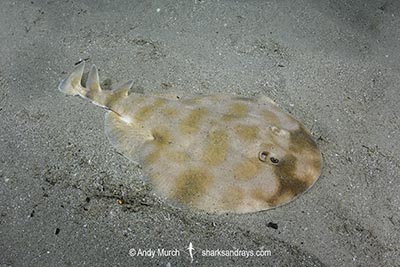Common names
Lesser Electric Ray, Caribbean Numbfish, Bancroft’s Electric Ray.
Binomial
Narcine bancroftii
Synonyms
Identification
A large electric ray with a teardrop-shaped body and a broadly rounded snout. Disc width equal to or slightly wider than long. Anterior disc margins convex. Pectoral fin apices broadly rounded. Eyes large and protruding, larger than spiracles. Spiracles oval-shaped with numerous papillae on posterior margin. Nasal curtain short and wide, posterior margin almost straight.
Pelvic fins broad. Tail broad based, with a pronounced lateral keel. Dorsal fins closely spaced, large, and angled backwards, with broadly rounded apices and convex posterior margins. First dorsal origin over pelvic fin posterior margin. Caudal fin sub-triangular, dorsal and ventral margins straight or mildly convex, posterior margin may be straight, or weakly concave or convex.
Colour
Dorsum light brown to greyish brown, often with darker blotches or broken rings. Snout often dark. Lateral keel and posterior margins of fins pale or white. Ventrum white, occasionally with darker blotches.
Size
Maximum length ~65cm. Size at birth ~9cm.

Conservation Status
LEAST CONCERN
The Caribbean Numbfish population has remained stable in the US since the early 1970s. Impact from fishing appears to low because this species does not inhabit muddy substrates where shrimp trawling occurs. Combined with a fast growth rate, the lesser electric ray has faired relatively well, but rising ocean temperatures will likely impact this species in the future.

Habitat
Tropical/subtropical seas. Benthic on soft substrates, sometimes adjacent to reefs, also estuaries and seagrass beds. From shallow inshore water to 35m.
Distribution
Western Atlantic. From North Carolina, USA to at least the north coast of South America, including the Gulf of Mexico and Caribbean Sea. Records from further south in South America probably refer to the closely related Brazilian electric ray – Narcine brasiliensis.
Reproduction
Aplacental viviparous. Litter size 1-15. Annual reproductive cycle.
Diet
Feeds mostly on benthic invertebrates.
Behavior
When pursued, lesser electric rays bolt forward obscured by a cloud of sand and then quickly bury themselves.
In the Leeward Islands, lesser electric rays congregate in shallow bays in January/February.
Reaction to divers
Fairly skittish. Usually moves away before a close approach is possible. May try to deliver a shock and then relocate when threatened.
Diving logistics
Seen occasionally on shallow reefs in Florida but generally more abundant further south. In the Leeward Islands, lesser electric rays are quite common in shallow bays and on sandy slopes around reefs.
I have seen aggregations of 30+ animals in 5m depth in sandy bays in Carriacou Island near Grenada. I have also seen numerous animals off deeper sand slopes while diving in Soufriere, Dominica.
What’s new
View our full list of updates
Similar species
Brazilian Electric Ray Difficult to distinguish. Pattern usually consists of transverse bands, and two very dark blotches on snout. Confined to Brazil, south of the Amazon and northern Argentina.








